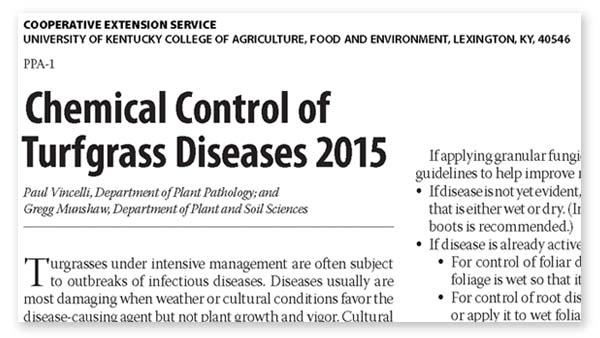 For the most part, TurfNet is a pretty secular Web site. However, extreme weather conditions and green committee meetings can instill the power of prayer in just about anyone. And if ever there was a bible in this business, the University of Kentucky's fungicide guide might be it.
For the most part, TurfNet is a pretty secular Web site. However, extreme weather conditions and green committee meetings can instill the power of prayer in just about anyone. And if ever there was a bible in this business, the University of Kentucky's fungicide guide might be it.The annual Chemical Control of Turfgrass Diseases by UK's Paul Vincelli, Ph.D., and Gregg Munshaw, Ph.D., is indeed one of the most anticipated publications of the year.
The 2015 edition of the guide is available for download through the University of Kentucky Extension Service. It contains information on a variety of common fungicides listed by active ingredient.
The guide also addresses risk of resistance for each chemistry, and ways turf managers can minimize the threat of resistance.
Other tips include improving product efficacy through proper application, non-target effects of fungicides.
Significant space is dedicated to reducing summer stress on cool-season turf putting surfaces. The authors show how raising mowing heights by 0.031-0.062 inch can be enough to provide relief to cool-season turf during times of heat stress, and can be combined with a program that includes reduced mowing frequency and increased lightweight rolling.
Other advice includes using smooth rollers rather than grooved, the role of foliar nutrition during times of stress, the importance of managing water use and minimizing leaf wetness from dew.
The authors also dedicate a considerable amount of space to control methods for specific diseases, including anthracnose, algae, brown patch, dollar spot, fairy ring, Pythium root dysfunction and various leaf spot and patch diseases.
Each disease-specific section includes information on conditions that are optimal for an outbreak, tips on disease avoidance and applicable curative control methods.
Finally, the authors include links to other online resources from within the UK turf community as well as from Purdue University and the University of Missouri.

